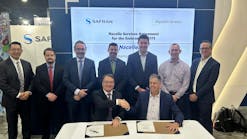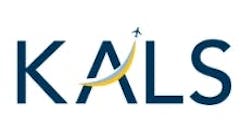Philly's Leonardo Delivers Radiation-Disaster Helicopters to United States as Hiring Surge at Plant Tops 1,000
PHILADELPHIA — Two helicopters made at Leonardo's Philadelphia assembly plant to check nuclear accidents and potential terror attacks are going through testing at Andrews Air Force Base in Maryland, as the company adds staff at the plant in anticipation of more sales to the U.S. government.
Leonardo, based in Italy, delivered the two AW139 helicopters last month to the federal National Nuclear Security Administration. The agency, according to its website, monitors public events such as the Super Bowl, and is on call 24 hours a day to respond to "accidents and incidents" affecting nuclear facilities or nuclear material, from Andrews and a second facility at Nellis Air Force Base in Nevada.
The aircraft type isn't new — Leonardo (formerly known as Finmeccanica) has sold more than 1,200 AW139s of different models since the 2000s, to 300 users in 70 countries, Clyde Woltman, who heads the Philadelphia plant, said in an interview last year. The company also has plants in Europe and North America, and a maintenance, repair, and overhaul facility in Santa Rosa County, Fla., near the U.S. Navy aviation base in Pensacola.
The particular mission of the helicopters assigned to the nuclear security administration was described to staffers by a then-NNSA officer, Jay Tilden, at a meeting at the plant last summer: The machines were outfitted with special radiation detection equipment to quickly measure radiation and help the agency respond. The agency has provided similar detection services for allies including Japan, which accepted its help when its Fukushima nuclear power station flooded and suffered major damage after an earthquake and tsunami in 2011.
"We are hitting on all cylinders," Woltman said during the NNSA visit last year. "We are hiring." The plant now employs more than 1,000, up from 650 in 2020, and has added new facilities on-site, including a $65 million training center. To help recruit workers it has funded scholarships at the Aviation Institute of Maintenance, a mile from the plant.
AW139, powered by dual Pratt & Whitney PT6 gas turbine engines, is faster and can fly longer than the Bell helicopters the agency has relied on since the 1990s. According to Leonardo, the AW139 can fly up to 190 mph, for more than five hours, and more than 700 miles, with a reserve tank. That's about the distance from Philadelphia to Orlando, or St. Louis.
The Air Force is replacing its current helicopters with the MH139, a military version of the AW139. Leonardo is assembling those aircraft in Northeast Philly, then moving them to the Boeing plant, where armaments and other equipment are added and the aircraft prepared for delivery to the military.
The 139-series helicopters can seat up to 15 passengers, plus two pilots. The Northeast Philly plant also builds TH-73A training aircraft for the U.S. Navy, and smaller aircraft for military, civilian, and police buyers (clients have included the New Jersey State Police).
The Leonardo plant is growing even as the larger, older Boeing helicopter factory at Ridley Park, Delaware County, has been scaling back its Chinook and Osprey assembly line employment. The Boeing complex, which includes the company's helicopter engineering and parts testing units, employs around 3,500, down from over 4,000 in the late 2000s, though the company says it plans to add some jobs over the next two years.
A third Philadelphia-area helicopter factory, shuttered by Sikorsky after its purchaser LockheedMartin Corp. consolidated helicopter operations to Connecticut three years ago, was reopened last year by Essington-based Piasecki Aircraft Corp.
That family-owned helicopter design company, which counts Boeing among its clients, is hiring 200 workers to produce new helicopters based on the Piasecki-designed Sea Knight ("Frog") helicopters built at Ridley Park in the 1950s and '60s, and plans eventually to employ at least 400 at the facility near Coatesville, Chester County.
_____
©2024 The Philadelphia Inquirer, LLC. Visit at inquirer.com. Distributed by Tribune Content Agency, LLC.




